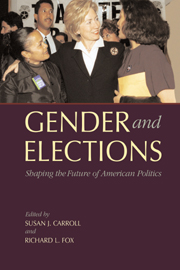Book contents
- Frontmatter
- Contents
- List of Figures, Text Boxes, and Photo
- List of Tables
- Acknowledgments
- List of Contributors
- Introduction: Gender and Electoral Politics into the Twenty-First Century
- 1 Presidential Elections
- 2 Voter Participation and Turnout
- 3 Voting Choices
- 4 Congressional Elections
- 5 African American Women and Electoral Politics
- 6 Political Parties and Women's Organizations
- 7 Advertising, Web Sites, and Media Coverage
- 8 State Elections
- Index
6 - Political Parties and Women's Organizations
Bringing Women into the Electoral Arena
Published online by Cambridge University Press: 05 June 2012
- Frontmatter
- Contents
- List of Figures, Text Boxes, and Photo
- List of Tables
- Acknowledgments
- List of Contributors
- Introduction: Gender and Electoral Politics into the Twenty-First Century
- 1 Presidential Elections
- 2 Voter Participation and Turnout
- 3 Voting Choices
- 4 Congressional Elections
- 5 African American Women and Electoral Politics
- 6 Political Parties and Women's Organizations
- 7 Advertising, Web Sites, and Media Coverage
- 8 State Elections
- Index
Summary
Woman-versus-woman races have grown increasingly common in congressional elections, but it is still rare in a highly competitive open seat for the U.S. House of Representatives that both parties would have female nominees. So when both the Democrats and the Republicans nominated women to run for the House from Pennsylvania's 13th Congressional district, it was not because the party organizations intentionally tapped women for the race. To get their party nominations, both Democrat Allyson Schwartz and Republican Melissa Brown had to defeat other would-be nominees in primary races. Schwartz beat her primary opponent 52 percent to 48 percent. Brown reached the general election by earning 39 percent of the primary vote, while her opponents obtained 35 percent and 26 percent, respectively. Both women saw their political parties' national campaign committees pour money into the race in the general election, but not before they had fended off tough intra-party opposition.
Schwartz, a state senator, had prominent supporters in the primary. The chair of the Montgomery County Democratic Party, along with the Philadelphia controller, a major political figure in the area, endorsed Schwartz when she announced her candidacy. She also received the support of EMILY's List, a Democratic group that recruits and trains pro-choice women candidates and provides resources to their campaigns. Donations from EMILY's List members helped Schwartz lead all primary candidates in fundraising by October 2003, a year before the general election.
- Type
- Chapter
- Information
- Gender and ElectionsShaping the Future of American Politics, pp. 143 - 168Publisher: Cambridge University PressPrint publication year: 2005



